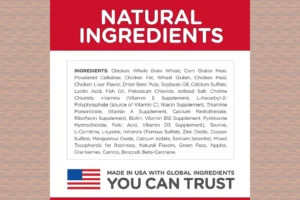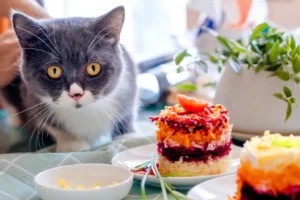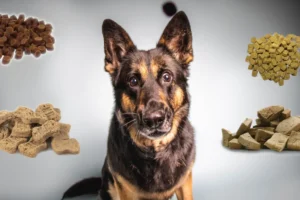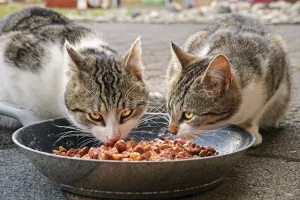Note: We may earn a commission from helpful, relevant links in our content. No cost to you. See our privacy policy.
Picture this: You’re standing in the pet food aisle, surrounded by colorful cans, pouches, and bags with delectable images of gourmet meals for felines.
It’s overwhelming, right? We’ve all been there, wondering which choice is the healthiest, tastiest, and most beneficial for our beloved furballs.
And it gets particularly tricky when we reach the wet cat food section. With so many brands, ingredients, and claims to digest, it’s hard not to question: “Am I making the best choice for my kitty?”
Take a deep breath and prepare to leave the guesswork behind. This post will guide you through the maze of wet cat food, illuminating its benefits and how to identify quality choices. Stick around, and you’ll be a feline nutrition whizz before you know it!

What Makes Wet Food a Good Option for Cats?
In the quest for optimal feline nutrition, wet cat food shines as an excellent choice. Let’s dive into why this type of food is beneficial for your furry friend:
- Hydration. Cats are notorious for not drinking enough water, making them susceptible to urinary and kidney issues. Wet cat food, being typically 70-80% water, is a great way to sneak in some extra hydration.
- High in Protein. Cats are obligate carnivores. Their bodies need a diet high in animal protein, and wet cat food can help meet this requirement efficiently.
- Lower in Carbohydrates. Compared to dry food, wet cat food usually contains fewer carbohydrates, aligning more closely with a cat’s natural diet.
- Easier to Eat. For kittens, senior cats, or those with dental issues, wet food is much easier to chew and digest.
- Enhanced Palatability. Let’s face it, cats can be picky eaters! The rich flavors and textures of wet food are often more appealing to them.
- Weight Management. Due to its high moisture and protein content, and lower calories per volume, wet food can help keep your cat feeling satiated and maintain a healthy weight.
With these tangible benefits, it’s no wonder that many cat owners are gravitating towards wet food. But how do you distinguish between good and not-so-good options?
Stay tuned, as we’re about to dive into the essential ingredients and what makes wet cat food high-quality in our next sections.
How Nutritious Is Wet Cat Food?
Beyond the appetizing appeal to our feline friends, wet cat food brings an array of nutritional advantages. Let’s explore the nutritional landscape of this popular cat food option.
Protein Levels: Fueling your cat’s carnivorous nature
Protein is the cornerstone of your cat’s diet.
It supports a range of bodily functions, such as muscle growth and repair, immune response, and the production of essential hormones and enzymes.
The AAFCO recommends a minimum protein level of 26% on a dry matter basis for adult cats and 30% for kittens. The unique feature of wet cat food is its high moisture content—approximately 75% to 78%—which means the protein level may appear lower due to the dilution effect.
It’s therefore crucial to check the dry matter basis (DMB) protein percentage, which excludes the water content. This means you calculate the protein percentage after removing the water content. Most cat food packaging doesn’t directly provide this figure, but you can calculate it if the label shows both protein and moisture percentages.
Wet food often contains a higher DMB protein level than dry food, making it a nutritious choice.
However, not all protein sources are created equal. Cats require certain essential amino acids found predominantly in animal proteins. The best wet cat foods have clear, identifiable animal-based proteins listed as the first ingredient—like chicken, beef, or fish—instead of vague terms like “meat byproducts” or “animal derivatives”.

For a high-protein wet cat food option, we recommend the Hill’s Science Diet Wet Cat Food, Adult, Urinary & Hairball Control. This wet cat food provides high-quality protein, primarily from chicken, to meet your cat’s protein needs effectively. Additionally, it promotes urinary health, which is beneficial considering cats’ propensity for urinary tract issues. Get it here.
Carbohydrates: Sizing down for your cat’s health
Cats, as carnivores, have limited need for carbohydrates.
Their natural diet—mice, birds, and other small animals—contains only around 2-3% carbs. Despite this, some commercial cat foods can contain carbohydrate levels as high as 50% on a dry matter basis.
Generally, the lower the carbohydrate content, the better it is for cats. A carbohydrate level below 10% DMB in wet cat food is considered excellent, while up to 20% is moderate and anything above this is high.
Fillers like corn, wheat, and soy are often used as cheap sources of carbohydrates but provide little nutritional value. They can also lead to weight gain and may be problematic for cats with allergies or sensitivities.
If you’re searching for a low-carbohydrate wet cat food, consider Royal Canin Feline Health Nutrition Loaf in Sauce Wet Cat Food. Its primary protein source is pork, and it’s low in carbohydrates, making it an excellent choice for your cat’s diet. It’s also enriched with Omega-3 fatty acids for a healthy, glossy coat. Check it out here.
Additives: They can be tricky
While some additives—like taurine, an essential amino acid—are necessary, others can be harmful.
Artificial colors, flavors, and preservatives (like BHA, BHT, and ethoxyquin) are best avoided. Look for natural preservatives such as mixed tocopherols (vitamin E).
In addition, beware of excessive amounts of ‘binding agents’ such as carrageenan, guar gum, and xanthan gum, which have been associated with digestive issues in some cats.
Vitamins and Minerals: The silent protectors
Wet cat food should contain a balanced mix of vitamins and minerals to support your cat’s health. Here’s a quick rundown of some essentials:
- Vitamins: Cats require vitamins A, B, D, E, and K. While vitamin C can be synthesized by cats, additional dietary vitamin C can have antioxidant benefits.
- Minerals: These include calcium, potassium, magnesium, zinc, iron, copper, and selenium. They play vital roles in processes like bone health, nerve function, and metabolism.
It’s important to ensure that the nutrients are in a form that’s easily digestible by cats. Also, avoid cat food that is excessively supplemented, as too much of certain vitamins or minerals can cause toxicity.
Calorie Content
Managing your cat’s calorie intake is crucial for maintaining a healthy weight.
Wet cat food typically contains fewer calories than dry food when served in equivalent volume due to its high water content. A typical can of wet cat food (3 oz) contains about 70-100 calories, ideal for a meal for an average-sized adult cat.
However, every cat is unique. The optimal calorie intake will depend on factors like age, activity level, and health status. Consult your vet to tailor the best diet plan for your feline friend.
Remember that nutritious cat food is one that caters to your cat’s specific dietary needs. A combination of quality animal-based protein, low carbohydrates, necessary additives, balanced vitamins and minerals, and an appropriate calorie count is the way to go when choosing wet cat food.
Always consult with your vet for advice tailored to your cat’s unique needs and circumstances.
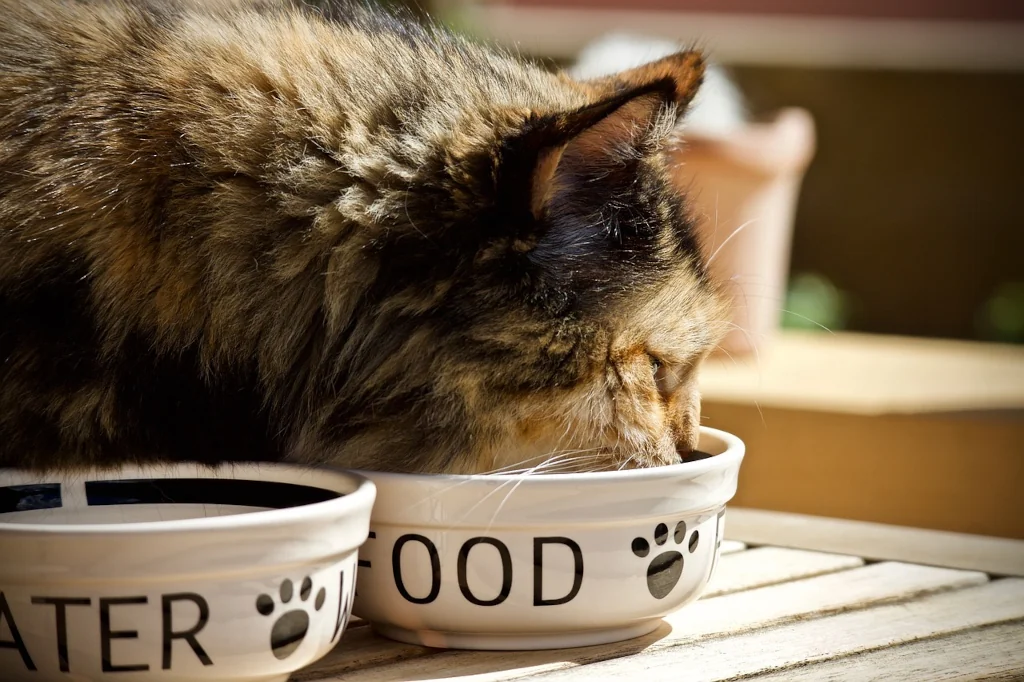
What to Look for When Buying Wet Cat Food?
When it comes to choosing the best wet cat food for your furry friend, there are several key factors to consider. Your choice should account for your cat’s age, health status, and taste preferences. Here are some practical tips to help guide you in the cat food aisle.
Consider Your Cat’s Life Stage
Cats need different nutrients at different stages of their life.
Kitten food, for example, is usually high in both protein and fat to support their rapid growth and development. Adult cats need a balanced diet to maintain their health, while senior cats might require more fiber and less fat in their diet.
Look for cat food that is appropriately labeled for your cat’s life stage.
Suggested read: Nutritional Needs for Every Cat Life Stage
Inspect the Ingredient List
High-quality wet cat food will list a specific type of meat—like chicken, beef, or fish—as the first ingredient, indicating it’s the primary component. Avoid products that list ‘meat by-products’ as the first ingredient as they’re often inferior sources of protein.
Additionally, keep an eye out for artificial colors, flavors, and preservatives, which are best avoided.
Check the Nutritional Adequacy Statement
A statement like ‘complete and balanced’ indicates that the food contains all the necessary nutrients your cat needs, as established by AAFCO. This statement also shows for which life stage the food is suitable.
Look for Digestible Carbohydrates
While cats don’t need a lot of carbohydrates, those present should be easy to digest. Whole grains, sweet potatoes, and carrots are better options than corn, wheat, or soy.
Opt for Transparency
Companies that provide detailed information about their ingredients, manufacturing process, and nutritional content demonstrate a commitment to quality. If you can’t find this information on the packaging, you might find it on the company’s website.
Taste and Texture Preferences
Every cat is different. Some cats may prefer pate-style foods, while others might like chunks or shreds in gravy.
Don’t be discouraged if your cat doesn’t take to a new food right away, and be prepared to try out a few different brands and styles.
You might want to try out the Blue Buffalo Wilderness High Protein, which comes in a variety of flavors like chicken, duck, and salmon, offering options to satisfy even the pickiest eaters. It’s grain-free and packed with real chicken, helping fuel your cat’s carnivorous cravings.
Consult Your Veterinarian
Your vet knows your cat’s health history and can provide valuable insight into the best diet for your cat, especially if they have special dietary needs or health concerns.
In line with the guidelines discussed above, we suggest considering Purina Pro Plan Urinary Tract Wet Cat Food. This product contains high-quality protein and low carbohydrate content. What sets it apart is its special formulation to maintain your cat’s urinary tract health by reducing urinary pH and providing low dietary magnesium.
Remember, not all cats are the same. Take the time to understand your cat’s specific needs and be patient in finding the food that works best for them. After all, their health and happiness are what’s most important.
Suggested: Popular Cat Food Brands Reviewed
Are There Any Cons to Wet Food for Cats?
While wet cat food offers numerous advantages, it’s only fair that we explore potential downsides too. Nothing is perfect, and cat owners should be aware of some considerations before making a feeding decision. Here are some cons that might be associated with wet cat food:
- Cost. Wet cat food can be more expensive than dry cat food, depending on the brand and quality. If you’re on a budget, it may be worth considering a mix of wet and dry food to balance costs.
- Storage and Shelf Life. Wet cat food, once opened, has a shorter shelf life compared to dry food. It needs to be refrigerated and used within a day or two, which might not be convenient for everyone.
- Dental Health. Dry cat food provides a crunch that can help clean a cat’s teeth. Wet food does not provide this benefit, so additional dental care may be needed to prevent dental diseases.
- Mess and Odor. Wet food can be a bit messy, especially if your cat is a messy eater. It also tends to have a stronger odor compared to dry food, which some cat owners might find less appealing.
Suggested read: Dry vs Wet Cat Food
Wet cat food presents a multitude of benefits for your feline friends, providing them with much-needed hydration, high-quality protein, and an enticing eating experience. Of course, selecting the best option requires a little knowledge and attention, but it’s a small price to pay for your cat’s health and happiness.
FAQs
Should cats have wet food every day?
Cats can have wet food every day, and it can be beneficial as it provides hydration and high protein content. The ideal diet may include a combination of both wet and dry food for a balanced diet.
How often should you serve your cat wet food?
The frequency of serving wet food depends on your cat’s age, weight, and health status. Generally, adult cats should be fed wet food twice a day, but always consult with your vet for personalized advice.
How do I transition my cat to wet food?
Transitioning your cat to wet food should be done gradually over a week. Start by mixing a small amount of wet food with their regular dry food, gradually increasing the wet and decreasing the dry until the transition is complete.
How long can you leave wet cat food out?
Unrefrigerated wet cat food should not be left out for more than 4 hours. After this, it can harbor bacteria and become unsafe for your cat to consume.
Is it okay to refrigerate leftover wet cat food?
Yes, leftover wet cat food can be refrigerated. However, it should be used within 2 days, and be sure to warm it to room temperature before serving as cats don’t like cold food.
Alex, a passionate animal lover, has experience in training and understanding animal behavior. As a proud pet parent to two dogs and three cats, he founded AnimalReport.net to share insights from animal experts and expand his knowledge of the animal kingdom.



